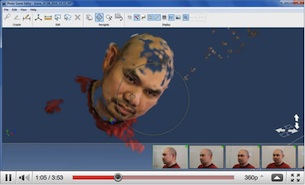Latest News
February 1, 2011
By Kenneth Wong
View the Video, Also watch Kenneth’s video report, compiled to illustrate cloud-hosted operations that are easier explained in animation than words. |
In December 2010, a pair of inquisitive, green eyes on the cover of Time magazine stared at holiday shoppers from newsstands, magazine racks and bookstores everywhere. It was the cover featuring Time’s Person of the Year. According to the accompanying article, the spotlight fell on Mark Zuckerberg, founder and CEO of Facebook, “for connecting more than half a billion people and mapping the social relations among them, for creating a new system of exchanging information, and for changing how we live our lives.”
Born out of a socio-technological experiment in a Harvard dorm room (or so the legend goes), Zuckerberg’s social networking enterprise has also changed the way we design. Now, design software makers large and small — from established names like Autodesk, Dassault Systèmes (DS), and PTC to upstarts like GrabCAD — are looking to introduce social media-inspired features into the collaborative workflow. An essential part of this revolution — let’s call it social engineering — is the cloud, the shared network.
Communal Content, Social Concepts
In February 2009, when SolidWorks, a DS subsidiary, decided to relaunch its free content-sharing community 3D Content Central, it took cues from Facebook — all the way to the light-blue color scheme and the minimalistic fonts. The revamped CAD community offered, among other things, the option to browse user profiles, comment on user-submitted 3D models (as you might your friends’ Facebook photos), and rate them (as you might random YouTube videos). In the latest release of the company’s SolidWorks CAD software (SolidWorks 2011), supplier- and user-submitted 3D models from 3D Content Central are accessible for download right from the CAD modeling window. Also, if you want to share a model with the community, you’ll be able to upload it to 3D Content Central right from the program window.
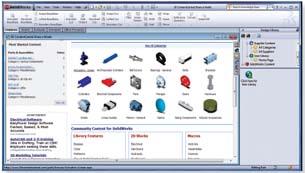 Models uploaded to 3D Content Central, readily available for download from within SolidWorks 2011’s modeling window. |
SolidWorks’ parent company, DS, maintains a community associated with its 3DVIA product line, a consumer-friendly lightweight 3D modeling and game development platform. Like 3D Content Central, the 3DVIA community also offers comments, rating, user profiles and other social media-like functions. Next year, DS plans to offer a project-management platform with social media-inspired features, called 3DSwYm (currently in closed beta, accessible to invited testers only).
PTC, makers of Pro/ENGINEER (now rebranded as Creo Elements/Pro), maintains a community called Planet PTC — complete with blog posts, video clips and discussion forums. The company plans to incorporate Windchill SocialLink, an Instant Messenger-like panel that promotes community-powered product development.
Possibly the youngest of the lot, GrabCAD, another free 3D content library powered by members, came online in 2009. Though at press time its registered members currently totaled a mere 1,400 or so, company founder and CEO Hardi Meybaum reports that “we are growing — 100% month over month.” In addition to shared content, GrabCAD also offers model conversion, technical drawing production, rendering and other complementary services.
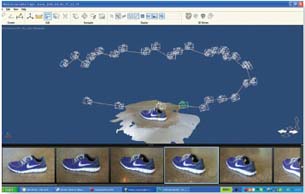 Constructing a 3D scene using 2D photos of an object taken from various angles. | 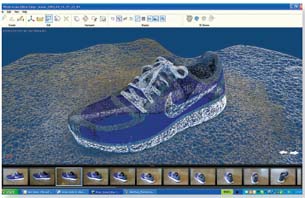 In the next version of Autodesk’s Project Photofly, you will be able to export the 3D scene as mesh data. |
As user-driven CAD communities spring up, some uploaded designs take on new lives, ending up in unexpected places. One of the most popular items on 3D Content Central is an assembly model of Homer Simpson holding a beer can and a doughnut. Its creator, Chris Tabern, wrote, “As an assembly, it’s absolutely awful and I’m horrified that over 18,500 people have downloaded it.” But that was in 2008. Today, Homer has been downloaded 60,515 times. Commenting on it, one member revealed, “We simulate a walkthrough ]of] our facility with Homer. This is very funny for the spectators.”
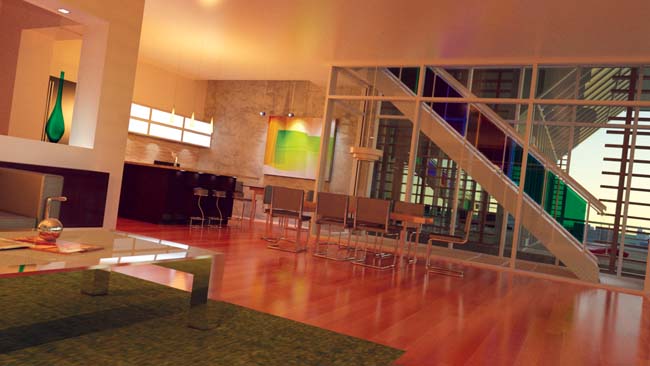 A 3dx Max interior scene, rendered using a cloud-hosted GPU cluster with NVIDIA Tesla GPUs. |
Tabern’s Homer, other users’ works, and standard components uploaded by part suppliers are yours for the experimenting. You may use them for inspiration, production — or laughter.
Not Just for Storage
The cloud is not just a virtual vault with infinite storage capacity, however. It’s also home to hundreds of supercomputers, dedicated servers with infinite computing horsepower. Up to now, for mere mortals, computing is, simply put, operating a box — a desktop, a laptop or a workstation. Sure, there are those with access to university research laboratories equipped with giant clusters. But these are the deities of high-performance computing (HPC), blessed with the authority to wake up mythical monsters like Jaguar or Blue Gene (installed at Oak Ridge and Lawrence Livermore National Labs, respectively).
The new computing paradigm, dubbed “infinite computing” by Autodesk, seeks to extend design and engineering beyond our individual boxes, giving us a way to reach into the supercomputers in the cloud. This means you can now compute like, and compete with, industry titans. Unlike Oak Ridge or Lawrence Livermore, you don’t have to shoulder the burden of feeding and housing an HPC monster onsite; you just need to pay for borrowing it.
Borrowing Computing Cycles
Several technology previews currently available at Autodesk Labs exemplify how Autodesk plans to incorporate on-demand HPC into its software titles. One of them, Project Photofly and Photo Scene Editor, lets you upload a series of digital photos of an object taken from slightly different angles, then convert them into a 3D scene comprising editable points. In the future, the software will let you export the constructed scene as mesh data.
The workflow lets you bypass the need to use digital scanners to capture the shape of an object, then export the results as point cloud data, editable in a CAD program like AutoCAD. The most computing intensive operations — automatic analysis of the uploaded photos, identifying points in 3D space and reconstruction of the scene — take place in a remote server cluster in the cloud, not in your own desktop’s CPU.
Similarly, Project Centaur, a technology preview that’s destined to become part of Autodesk Inventor, lets you upload your Inventor 3D model to a remote server, run a series of optimization tests, and retrieve recommended parameter changes. The plug-in uses the processors in a remote cluster to solve optimization equations, so your own Inventor session won’t be subjected to a performance decrease.
Cloud-hosted Rendering
Another technology in development is expected to let Autodesk 3ds Max users tap a remote GPU cluster to render their 3D scenes. By offloading the ray-tracing algorithms to a dedicated GPU cluster in the cloud, 3ds Max can perform the operation in just a fraction of the time it would have taken to do the same on a desktop or a laptop.
“]Cloud-hosted GPUs] are all running exactly the same iray software ]from mental images, a subsidiary of NVIDIA] that comes with 3ds Max,” said Michael Kaplan, VP of strategic development, mental images. “We can guarantee that the image that you get from ]the cloud-hosted iray renderer] is exactly the same, pixel for pixel, as what you would get from 3ds Max.”
Similarly, Autodesk is developing a browser-based rendering tool, dubbed Project Neon. The application lets you upload DWG files with pre-defined camera angles to a remote server from a browser, then retrieve rendered images. Like the 3ds Max function mentioned above, Neon uses the horsepower of a cloud-hosted cluster to render the DWG files, so your local CPU and GPU remain free to run other applications.
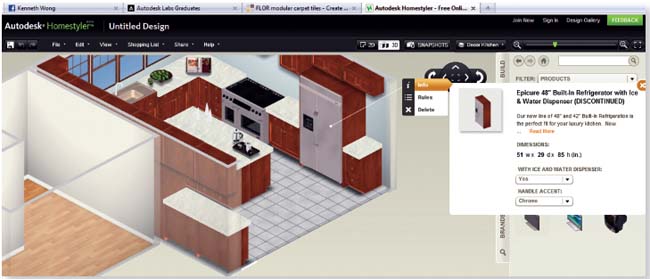 Autodesk Homestyle exemplifies how cloud-hosted design data and remote rendering can create interactive sales and marketing applications. |
Whereas Project Neon is still in test phase, Mackevision’s F_BOX Picture Shooter, a fully functional browser-based rendering application, is already in the market. No client software, no installation. All you need to use the web-hosted software is a log-in and a password. Primarily meant as a rendering program for manufacturers who need to churn out many iterations of a product, you may use F_BOX Picture Shooter and the Media Server to let authorized digital artists render photo-realistic images of the same product. The application uses Chaos Group’s V-Ray GPU-accelerated rendering technology to deliver images. See page 8 for more details.
New Experiences for Consumers
If the vision of DS’ CEO Bernard Charles comes true, shopping for a Valentine’s Day present for your significant other online will no longer be the same. You may still log on to his or her favorite store. But, instead of looking at a JPEG thumbnail of the item you’ve been receiving hints about for months, Charles imagines you’d be inspecting a 3D model of the product, which you can flip, open, rotate and even switch color.
Social Statistics |
Charles isn’t conjuring up a romantic vision — even though, as a French man, he’s entitled to. With his company’s design software, he’s actively promoting the use of what he calls “lifelike experiences” to extend the lifecycle of 3D design data.
Early examples of Charles’ vision can be seen at French luxury good merchant EspaceMax’s website. In partnership with DS, the retailer has created several 3DVIA-powered scenes with designer handbags and purses to allow online shoppers to interact with the product virtually. (To view the scene, visit here.)
Autodesk’s version of the same application can be seen in Autodesk Home Styler, a web-based application that lets you plan a room by dragging and dropping objects, visualize the result as a rendered 3D scene, and share snapshots of your creation on Facebook. Merchants like tile maker FLOR, kitchen appliance maker Dacor and other household brands supply the material choices.
This emerging practice — using cloud-hosted design data to let consumers digitally experience products before they buy them — extends engineering beyond manufacturing into sales and marketing.
Open-source Design?
Zuckerberg’s social network becomes a success story partly because of the technology that lets us connect across time and space. Perhaps more important, for reasons sociologists will continue to debate for years, we made a conscious decision to leave the cocoon of isolation to join the cyber masses, to take a chance on millions of strangers around the world.
The culture shift, high bandwidth connections and new strategies by software makers are expected to revolutionize the design discipline, too, from an isolated process confined to secrecy to a social experience conducted in the open.
More Info:
Autodesk
Dassault Systèmes
Facebook
GrabCAD
Mackevision
mental images
NVIDIA
PTC
YouTube
Kenneth Wong writes about technology, its innovative use, and its implications. One of DEs MCAD/PLM experts, he has written for numerous technology magazines and writes DEs Virtual Desktop blog at deskeng.com/virtual_desktop. You can follow him on Twitter at KennethwongSF, or send e-mail to [email protected].
Subscribe to our FREE magazine, FREE email newsletters or both!
Latest News
About the Author
Kenneth Wong is Digital Engineering’s resident blogger and senior editor. Email him at [email protected] or share your thoughts on this article at digitaleng.news/facebook.
Follow DE






